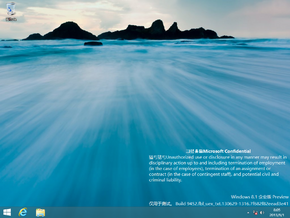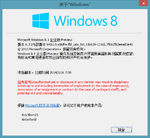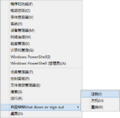Windows 8.1 build 9452 (fbl_uex_txt.130629-1316)
| Build of Windows 8.1 | |
 | |
| OS family | Windows NT |
|---|---|
| Version number | 6.3 |
| Build number | 9452 |
| Build revision | 0 |
| Architecture | x86 |
| Build lab | fbl_uex_txt |
| Compiled on | 2013-06-29 |
| Expiration date | |
| Timebomb | 2014-01-15 (+200 days) |
| SKUs | |
| Enterprise | |
| About dialog | |
Windows 8.1 build 9452 (fbl_uex_txt.130629-1316) is a pre-RTM build of Windows 8.1, which was originally found on a prototype Intel Clover Trail development kit, and was uploaded to the Chinese website BetaWorld on 7 November 2022.[1] It was later shared on 22 October 2024 only in the Simplified Chinese language.
Incremental quality-of-life improvements have been made across various system surfaces, particularly within the Metro shell and applications. Improvements to debugging facilities in the Internet Explorer 11 developer tools have been added, and a new kiosk mode lockdown feature was introduced, along with backports of two Windows Embedded features across client editions. Work on improving help facilities has started, and significant updates to existing multimedia applications have also been implemented. Minor updates to workplace join functionality and family safety features have also been added.
New features and changes[edit | edit source]
FBL_PARTNER_OUT25 build 9448 and FBL_LOC build 9449 would have produced an otherwise entirely unreliable and inconsistent set of changes, as certain functionality would not yet have been merged into these branches.Windows Setup[edit | edit source]
Out-of-box experience[edit | edit source]
Minor localization changes against the out-of-box experience were made against the initial onboarding animation and the Personalization page; specifically, the second step displayed during the onboarding animation, "Connect", was rephrased such that it now reads as "Get online", and the example computer name in the Personalization page was changed to home-pc.
User interface[edit | edit source]
Desktop UI[edit | edit source]
Taskbar[edit | edit source]
The Quick Links context menu (commonly brought up via the Win+X key combination) has been updated to now support directly logging out of the system through the shutdown sub-menu.
File Explorer shell[edit | edit source]
It is now possible to access the logged-in account's profile root folder from within the File Explorer user interface.
Internet Explorer[edit | edit source]
The F12 Developer Tools have been updated to now automatically load the current page's HTML source code into the JavaScript debugger as the default tab. In addition, new submenus linking to external webpages for reporting site issues and developer resources have been added. New simplified iconography for various toolbar resources, in addition to a "Send Feedback" button positioned at the top-right corner of the tools window, have also been added.
Dial-up connection support has been removed from the web browser.
Control Panel[edit | edit source]
Family Safety[edit | edit source]
The scope of blockable Metro UI applications has been expanded to not only include video games, but also to applications of all types.
Work Folders[edit | edit source]
Work Folders setup now supports directly entering a workplace URL in place of a work email address for workplace join. Workplace join attempts are now also performed automatically if a new system joins an Active Directory domain, eliminating the need to manually set up workplace configuration settings such as enabling mobile device management.
Metro UI[edit | edit source]
Start screen[edit | edit source]
The Start screen Customization charm has been updated; the layout of the charm has been vertically centered, and the color wheel has been updated to feature all selectable colors in the correct orders. Five new background presets (including one dynamically-animated background) have been added as selectable customization options, all of which were included as part of the final release.
The application launch animation has been reverted to the previous version included as part of Windows 8.
Task Switcher[edit | edit source]
Metro application "ghosts" shown when hovering over the Task Switcher hot-corner are less pronounced compared to the previous build.
PC settings[edit | edit source]
It is now possible to specify photo/video import as a valid AutoPlay option for MultiMediaCard-based storage media. The PC info subpage now displays the current machine's serial number, and VPN providers now use the appropriate plugin name in place of their respective AppX package names. A dedicated page for the Assigned Access security feature, discussed later in the article, has been added.
Minor localization changes have been introduced across various PC settings sub-pages. Clarifications have been made towards the Personalization and Devices subpages, and explanations on how to uninstall a Metro application as well as how the Narrator accessibility tool works have been added.
Applications[edit | edit source]
Skype[edit | edit source]
The Skype instant messenger application has been added as a direct replacement for the Windows Live Messaging application included as part of Windows 8's communications suite. As the relevant server infrastructure for this version of Skype no longer exists, it is not possible to use the application.
Notifications from this application are also displayed on the lock screen by default.
Help and Tips[edit | edit source]
The Help and Tips application is no longer an application stub, but rather a fully-fledged help resource. In its current state, the application is mostly a design mockup for the modernized help interface and does not have any actual functionality tied to it, apart from navigation across differing help categories.
Six new help categories are present in the application, all focusing on basic functions such as the Start screen, user interface navigation, application behavior, cloud synchronization, settings configuration, and an overview of new features introduced in the operating system. All content consists of placeholders, and the application includes toggles for changing content to adapt to both mouse and touch input modes.
Reading List[edit | edit source]
Page thumbnails are no longer automatically generated when sending an article to the Reading List.
Alarms[edit | edit source]
Disabled alarms will now always remain colored even if they are turned off. The correct hinting is now used for timer clock faces, and minor compacting adjustments have been made to each page layout; the alarm edit page's Repeat and Sound columns have been slightly moved to the left, and the AM and PM time options are now closer to each other than in the previous build.
Photos[edit | edit source]
It is now possible to include additional folders as part of the Photos library. SkyDrive integration has also been added to the application, allowing for file synchronization between the local machine and Microsoft servers. New crop aspect ratio modes have also been added:
- 9:13 (replaces 4:6 mode)
- 10:15/2:3 (replaces 5:7 mode)
- 13:18 (replaces 8:10 mode)
Xbox Music[edit | edit source]
The Xbox Music application has received a significant user interface redesign; album details are now located in a separate page rather than as a modal dialog, and a new design for the album track list has been added. It is no longer possible to categorize music based on the contents of local storage and/or on the logged-in account's SkyDrive storage, and the playlist user interface has also been simplified.
Xbox Live/Microsoft account authentication has been removed. Categories for radio stations and the Explore menu have been removed, and artists are now sorted by the first characters of their names. A new light theme has also been introduced across most application surfaces, excluding the sidebar and app bar.
A feedback menu has also been added, allowing the user to submit a report to Microsoft suggesting potential improvements (with Like or Dislike preferences) or reporting bugs within the application. Up to 1,024 characters can be typed per report.
Xbox Video[edit | edit source]
Because of the Xbox Video Marketplace's discontinuation, the Xbox Video application no longer includes any sort of functionality related to the former marketplace; it is now a standalone video player containing basic playback functionality. Xbox Live authentication has been removed, and the Share/"Play To" button has been removed from the app bar.
Maps[edit | edit source]
Bus route time estimates have been removed from the Directions menu, and all search categories including (but not limited to) points of interest, dining, and shopping have been removed. The search bar has been changed to omit the words "or business" for neutrality.
Weather[edit | edit source]
It is no longer possible to use the approximate location for determining local weather information, and the user is now asked to directly specify such information upon startup. The "Use Precise Location" feature and submenus for weather maps and ski resort locations have been removed.
Miscellaneous[edit | edit source]
Windows Security[edit | edit source]
Assigned Access[edit | edit source]
A dedicated kiosk mode function dubbed "Assigned Access" has been implemented, allowing a computer to serve a single, dedicated purpose such as displaying digital signage or providing automated teller machine (ATM) functions. A system operator can configure a user account to enable kiosk functionality and optionally launch an application as its dedicated system shell (via the Embedded App Launcher), while also locking down non-essential functions to prevent malicious actors from gaining full system control.
This feature is exposed in both the PC settings application as well as within a newly-added Windows PowerShell module named AssignedAccess, which exposes three commandlets: Get-AssignedAccess, Set-AssignedAccess, Clear-AssignedAccess
In this mode, access to the Windows system shell (including the desktop and the Start screen) is disabled, and most keystrokes that interface with aspects of the Windows operating system are disabled by the Keyboard Filter driver as a security measure.
Windows Embedded feature backports[edit | edit source]
The Embedded App Launcher utility and Keyboard Filter Driver from Windows Embedded SKUs have been backported to client editions, in part due to the addition of the Assigned Access feature introduced in this build.
The Embedded App Launcher allows a specific system application to be invoked as the primary shell upon logon, whereas the Keyboard Filter driver allows the system operator to include or exclude certain keystrokes from being registered, based on values set in the Windows system registry.
Windows PowerShell[edit | edit source]
The following modules have been introduced into Windows PowerShell:
AssignedAccess
New commandlets for the following modules have been added:
AssignedAccessGet-AssignedAccess,Set-AssignedAccess,Clear-AssignedAccess
CimCmdletsImport-BinaryMiLog,Export-BinaryMiLog
Microsoft.PowerShell.UtilityGetAlgorithmType,Get-FileHash[b]
PSDesiredStateConfigurationgcfg,glcm,sacfg,slcm,rtcfg,tcfg,Get-DscResource,New-DSCCheckSum
The following commandlets have been removed:
NetEventPacketCaptureGet-NetEventVm
PSDesiredStateConfigurationGet-DynamicKeyword,Get-FileHash[c]
The following modules were renamed:
PcsvDevice(fromPCSVDevice)
Windows Event Log[edit | edit source]
Event log categories for the Embedded App Launcher, Keyboard Filter driver, and out-of-box experience user interface events have been added.
Scheduled Tasks[edit | edit source]
The Customer Experience Improvement Program now has an analytics upload task. Dedicated scheduled task categories for Windows Live account operations have been added, and a dedicated auto-join task for Workplace Join that is triggered upon joining an Active Directory domain as well as Windows Portable Devices SQM upload tasks have also been added.
A startup task for the backported Embedded App Launcher feature has also been included.
Recovery Drive[edit | edit source]
The minimum required drive size for creating a recovery drive has been increased to 512 MB, from the previous requirement of 256 MB.
Fonts[edit | edit source]
The Yu Mincho Ming CJK font family has been added to the operating system.






























































